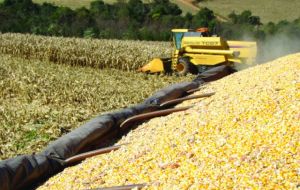MercoPress. South Atlantic News Agency
Brazil’s success with second season crop behind record production of corn
 “Reduced are does not mean reduced output”, it means Safrinha more than compensates
“Reduced are does not mean reduced output”, it means Safrinha more than compensates Increased success in second crops is behind the continued strength in Brazil's corn production despite a decline in plantings, the US Department of Agriculture has said.
Farmers in the world's third-biggest exporter of the grain are planting smaller areas, with 2009-10 sowing believed to have fallen by 800,000 hectares, a drop reflected in the lower main crop production. At 33.5 million tons, Brazil's main crop, which is currently nearing the end of harvest, will be the lowest in four years.
However in a briefing saying that “reduced area does not reduce output”, the USDA noted Brazilian farmers' increased success in second - or so-called safrinha -plantings, which will take production of this crop to a record 20 million tons.
“Second season corn production continues to increase” the USDA said, in follow-up briefing to Friday's crop numbers, which increased to 53.5 million tons the department's estimate for Brazil's corn output in 2009-10.
Safrinha corn - for which sowing was completed last month, and is focused in the states of Mato Grosso and Parana – was historically a small concern, accounting for less than 5% of corn production in the early 1990s compared with the estimated 37% this season.
However, output has grown along with the increasing sophistication of Brazilian farming, which has become a huge market for cutting edge farm machinery as well as practices such as second and double crops.
“Average yields continue to improve with rapid adoption in the latest production and machine technology and development of better soil management techniques,” a separate report from USDA staff based in Brasilia said.
Some are adopting an “agrosilvipastoril” approach in which three years of crops, including eucalyptus grown as fuel for steel mills, are followed by three years or more of pasture.
Mato Grosso farmers have developed a rotation of two seasons of soybeans, each followed by safrinha corn grown with brachiaria grass. This safrinha double crop allows for 60 days of cattle grazing after harvesting.
The rotation dictates that a third season of soybeans is followed by brachiaria grass for up to two years, again to support cattle grazing.




Top Comments
Disclaimer & comment rulesCommenting for this story is now closed.
If you have a Facebook account, become a fan and comment on our Facebook Page!